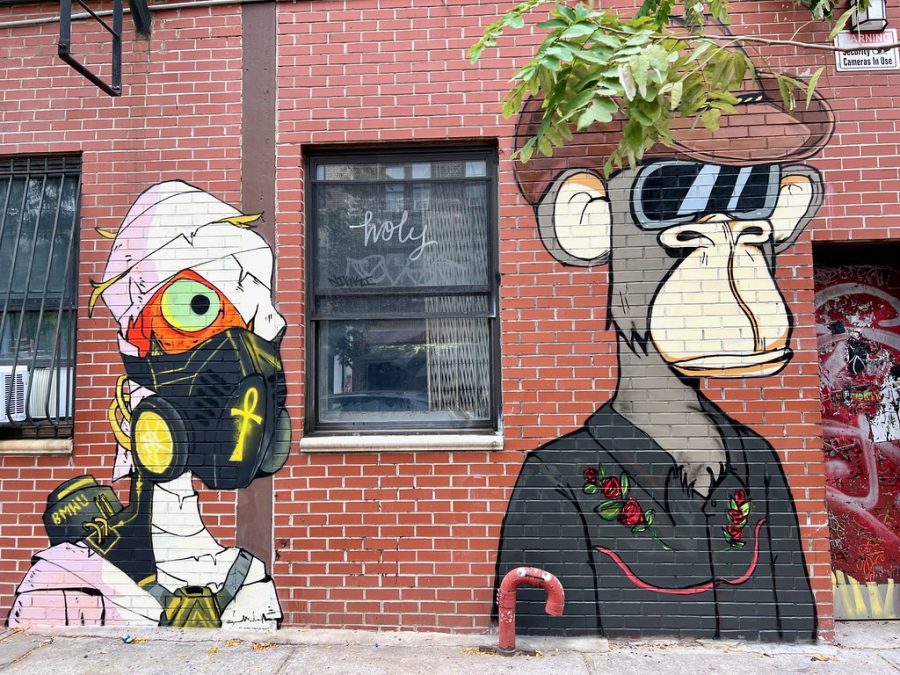NFTs: What are they, and why are they harmful?
In the past few months, NFTs have been gaining attention from all corners of the internet. From influencers starting their own line of NFTs to celebrities openly denouncing them, it can be confusing to understand what NFTs are and why they are shrouded in support and controversy.
So, what exactly is an NFT? And how can they have damaging effects?
The acronym NFT stands for non-fungible token, which means that one token can not be exchanged or replaced with another. A signed baseball or a special edition trading card are examples of something non-fungible.
An NFT can be anything digital, including images, videos or even music. These tokens are bought and sold using cryptocurrency, which is a form of digital currency that does not have to face the regulations and centralization of U.S. dollars.
The most used cryptocurrency for NFTs is Ethereum, but other digital coins can be used. Ethereum uses blockchain technology, which is used to transfer cryptocurrencies between owners, while also keeping track of transactions. It is this technology that registers the NFT to a specific owner.
In summary, NFTs are forms of unique digital art that are primarily bought using the Ethereum cryptocurrency. But why are these tokens going for so much money? The explanation lies in the same reason physical art can go for so much. Wealthy people are willing to pay for something unique and personalized.
Another reason is NFT flipping, which is when someone buys a token at a specific price and then sells it for a higher price later. These tokens have been going for unfathomable amounts of money with an artist named Beeple selling one for a whopping $69 million.
Despite the significant amounts of money these digital tokens are earning, I believe NFTs do more harm than good. The market of NFTs is currently filled with scams, with the rug pull being a common one.
This scam is also common in different cryptocurrencies, and it involves the creators of a new project baiting investors to put money into what they believe will be an idea with high growth potential.
While this new project gains attention and the price increases, the creators take all of the profits and abandon the project abruptly, causing investors to lose large amounts of money due to the price plummeting, not unlike a rug being pulled from under them. This recently occurred with a project known as “Evolved Apes” NFTs, which made investors lose over 2.7 million dollars.
Another reason NFTs are harmful is because of their negative impact on the environment. The blockchain technology that Ethereum and NFTs run on requires users known as “miners” who provide the blockchain with their signature “blocks” of transactions. In return, they receive tokens of Ethereum as compensation.
This process involves solving complex puzzles with unbelievable amounts of computing power. According to statistics from digiconomist.net, one single Ethereum transaction requires the electrical power that the average U.S. household uses in nearly nine days. This source also states Ethereum’s annual carbon footprint is comparable to the entire country of Sweden.
With rug pull scams making people lose millions, along with the electricity use and carbon emissions NFTs contribute to, they are detrimental both economically and environmentally.
For anyone considering buying NFTs to those who just wanted to know what exactly they were, I hope you do research on the effect these tokens have on both our economy and the world. Ask yourself: Is it worth it?
Your donation will support The Lion's Roar student journalists at Southeastern Louisiana University.
In addition, your contribution will allow us to cover our annual website hosting costs.
No gift is too small.

Cade Roland is a Finance major from Lafayette, LA. He joined the Lion's Roar in February of 2022. He graduated from Early College Academy in 2021. Outside...








Kevin • May 6, 2022 at 1:41 pm
I never thought that they would be this harmful. I guess that’s the reason why Wikipedia stopped accepting NFT donations recently https://web3wise.com/wikipedia-has-stopped-taking-cryptocurrency-donations/
Ray DeJean • Feb 11, 2022 at 9:42 am
Good article but I will respectfully disagree that NFTs are harmful. People make bad investments in stocks and real estate every day, and we don’t say that stocks and real estate are harmful. Also, Ethereum is changing to a proof-of-stake consensus protocol this year. It does not have the energy requirements of the current protocol, proof-of-work. I’d love to see a followup article discussing some the benefits and use cases for NFTs.
mt wight • May 22, 2022 at 5:45 am
There are no benefits of NFT, you muppet. This article has enough info about the entirety of NFT, which is nonsensical and litigious piece of scam that people use to extort from investors and stealing someone’s work and then slap it with a price tag.
Connie Elmer • Feb 9, 2022 at 2:09 pm
Well written and informative!